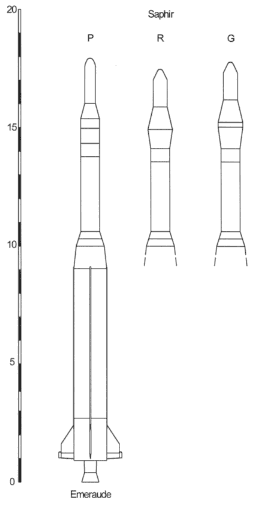Saphir (rocket)
 A diagram of the Saphir rocket | |
| Function | Sounding rocket |
|---|---|
| Manufacturer | SEREB |
| Country of origin | France |
| Size | |
| Height | 17.77 metres (58.3 ft) |
| Diameter | 1.40 metres (4 ft 7 in) |
| Mass | 18,058 kilograms (39,811 lb) |
| Stages | 2 |
| Associated rockets | |
| Family |
Pierres Précieuses ("Precious Stones") |
| Derivatives | Diamant |
| Launch history | |
| Status | Retired |
| Launch sites | CIEES/Hammaguira |
| Total launches | 15 |
| Successes | 13 |
| Failures | 2 |
| First flight | 5 July 1965 |
| Last flight | 27 January 1967 |
| First stage – Emeraude | |
| Engines | 4 Vexin-B |
| Thrust | 301.55 kilonewtons (67,790 lbf) |
| Specific impulse | 251 seconds |
| Burn time | 93 seconds |
| Fuel | N2O4/UDMH |
| Second stage – Topaze | |
| Thrust | 120 kilonewtons (27,000 lbf) |
| Specific impulse | 255 seconds |
| Burn time | 39 seconds |
| Fuel | N2O4/UDMH |
Saphir VE231 (French, meaning sapphire) was a French sounding rocket. It was part of the "pierres précieuses" ("precious stones") family of launch vehicles. Saphir was used between 1965 and 1967 and had a payload capacity of 365 kilograms (805 lb). The rocket could reach a maximum altitude of 1,000 kilometres (620 mi) and produced thrust of 280 kilonewtons (63,000 lbf) at launch. Saphir had a launch mass of 18,058 kilograms (39,811 lb), a diameter of 1.40 metres (4 ft 7 in) and a length of 17.77 metres (58.3 ft).[1]
Saphir was launched 15 times, from July 5, 1965 to January 27, 1967. The Diamant rocket, which carried the first French satellite, Asterix-1, into orbit, was developed from the Saphir with the addition of a third stage. After the successful launch of Diamant, Saphir rockets were used to test technologies for France's burgeoning intercontinental ballistic missile development—namely radio and inertial guidance, warhead separation, and ablative heat shielding of a re-entry vehicle.[1][2]
See also
References
- 1 2 Wade, Mark. "Saphir VE231". Astronautix. Retrieved 28 April 2018.
- ↑ Serra, Jean Jacques. "The Precious Stones". Sat-Net. Retrieved 28 April 2018.